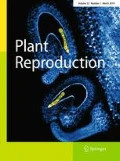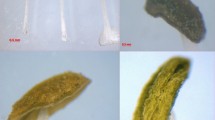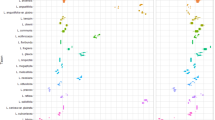Abstract
In the date palm, a dioecious mode (separate male and female individuals) and the late initial reproductive age (5–10 years) are major practical constraints for genetic improvement. Early selection on young seedlings could enhance breeding programmes and generate experimental male and female genetic stocks, but no cytogenetic protocol exists for sex determination in an immature date palm. Here we describe a cytological method based on chromomycin staining which demonstrates the occurrence of sexual chromosomes carrying distinctive nucleolar heterochromatin and thus offers, for the first time, the possibility of identifying male and female individuals by simple analysis of root meristems. This observation has been extended by in situ rDNA hybridization, confocal microscopy and dual-label flow cytometry of nuclei.
Similar content being viewed by others
References
Anonymous (1992) Annuaire FAO de la production, vol 46. UN Food and Agriculture Organization, Rome, Italy, p 112
Al-Salih AA, Al-Najjar NR, Al-Mashhadani AN (1987a) A study on the chromosome number of two specific female date palm cultivars. Date Palm J 5: 134–143
Al-Salih AA, Hussain N, Al-Jarrah A (1987b) Chromosome number of a date palm male cultivar Ghannami Akhdar. Date Palm J 5: 128–133
Beal JM (1937) Cytological studies in the genusPhoenix. Bot Gaz 99:400–407
Bendiab K, Baaziz M, Brakez Z, My Sedra H (1993) Correlation of isoenzyme polymorphism and Bayoud-disease resistance in date palm cultivars and progeny. Euphytica 65: 23–32
Bounaga N (1993) Le palmier dattier: rappels biologiques et problèmes physiologiques. In: Physiologie des arbres et des arbustes en zones arides et semi-arides. Libbey Eurotext, Paris, pp 323–333
Brac de la Perrière R, Benkhalifa A (1991) Progression de la fusariose du palmier dattier en Algérie. Sécheresse 2: 119–128
Chattopadhyay D, Sharma AK (1991) Sex determination in dioecious species of plants. Feddes Reper Z Bot Taxon Geobat 102:29–55
Durand R, Durand B (1984) Sexual differentiation in higher plants. Physiol Plant 60: 267–274
Fakir S, Carbonnier J (1992) Effet métaxénique des pollens chez le palmier dattier (Phoenix dactylifera). Rev Res Amelior Prod Agr Milieu Aride 4: 11–16
Frankel OH (1989) In: Brown AHD, Frankel OH, Marshall DR, Williams JT (eds) The use of plant genetic resources. Cambridge University Press, pp 245–260
Geber G, Schweizer D (1987) Cytochemical heterochromatin differentiation inSinapis alba (Cruciferae) using a simple airdrying technique for producing chromosome spreads. Plant Syst Evol 158: 97–106
Gerlach WL, Bedrook JR (1979) Cloning and characterization of ribosomal RNA genes from wheat and barley. Nucleic Acids Res 7: 1869–1885
Godelle B, Cartier D, Marie D, Brown SC, Siljak-Yakovlev S (1993) Heterochromatin study demonstrating the non-linearity of fluorometry useful for calculating genomic base composition. Cytometry 14: 618–626
Heslop-Harrison JS, Schwarzacher T, Anamthawat-Jonsson K, Leitch AR, Shi M, Leitch IJ (1991) In situ hybridization with automated chromosome denaturation. Technique A J Methods Cell Mol Biol 3: 109–116
Lakhoua H (1966) Contribution à l'étude de la métaxénie chez le palmier dattier et son utilisation en Tunisie. Ann de l'INRAT 39: 3–29
Louvet J, Toutain G (1973) Recherche sur les fusarioses. VIII. Nouvelles observations sur la fusariose du palmier dattier et précisions concernant la lutte. Ann Phytopathol 5: 35–52
Marie D, Brown SC (1993) A cytometric exercise in plant DNA histograms, with 2C values for 70 species. Biol Cell 78: 41–51
Marks GE (1975) The Giemsa-staining centromeres ofNigella damascena. J Cell Sci 18: 19–25
Martin J, Hesemann CU (1988) Evaluation of improved Giemsa C- and fluorochrome banding techniques in rye chromosomes. Heredity 61: 459–467
Negrutiu I, Sala F (1991) Sexual development in plants: an open question of strategic importance. Plant Sci 80: 1–6
Nixon RW (1928) Immediate influence of pollen in determining the size and time of ripening of the fruit of the date palm. J Hered 19: 240–254
Osman AMA, Reuther W, Richson LC (1974) Xenia and metaxenia studies in the date palm (Phoenix dactylifera). Date Growers Inst Rep 54: 6–16
Ostergreen G, Heneen KW (1962) A squash technique for chromosome morphological studies. Hereditas 48: 332–341
Oudejans JH (1974) Date palm. In: Simmonds NW (ed) Evolution of crop plants. Longman, London, pp 229–231
Parker JS, Clark MS (1991) Dosage sex-chromosome systems in plants. Plant Sci 80: 79–92
Sarkar S (1956) Sex chromosome in Palm. Genet Iber 9: 133–142
Schweizer D (1976) Reverse fluorescent chromosome banding with chromomycin and DAPI. Chromosoma 58: 307–324
Sinoto Y (1929) Chromosome studies in some dioecious plants, with special reference to the allosomes. Cytologia 1: 109–191
Soliman AS, Al-Mayah AA (1978) Chromosome studies in date palmPhoenix dactylifera L. Microsc Acta 80: 145–148
Suganuma H (1984) Enzymatic determination of the sex of dioecious plants at the seedling stage. Jpn Kokai Tokyo Koho JP 61 58, 598 (patent)
Tomlinson PB (1990) The structural biology of palms. Clarendon Press, Oxford, UK
Westergaard M (1958) The mechanism of sex determination in dioecious flowering plants. Adv Genet 9: 217–281
Author information
Authors and Affiliations
Rights and permissions
About this article
Cite this article
Siljak-Yakovlev, S., Cerbah, M., Sarr, A. et al. Chromosomal sex determination and heterochromatin structure in date palm. Sexual Plant Reprod 9, 127–132 (1996). https://doi.org/10.1007/BF02221391
Received:
Accepted:
Issue Date:
DOI: https://doi.org/10.1007/BF02221391




